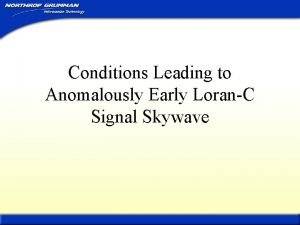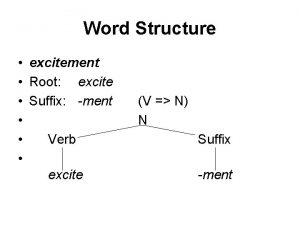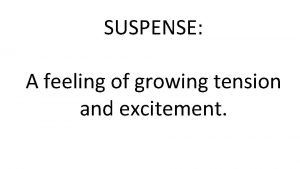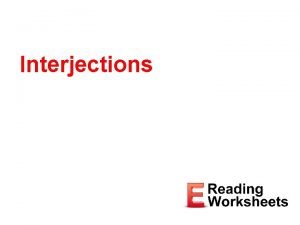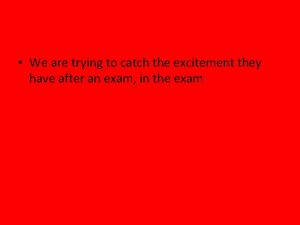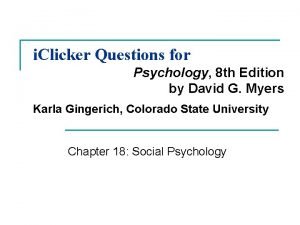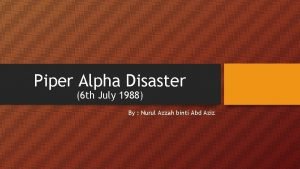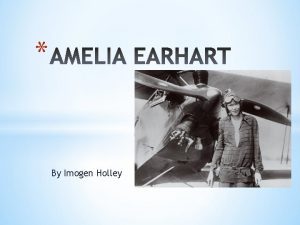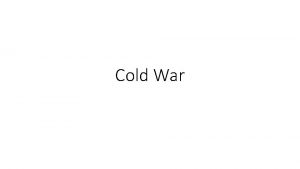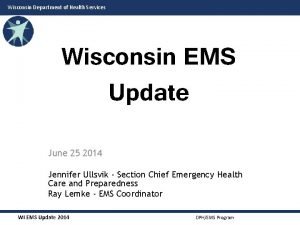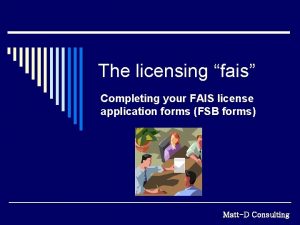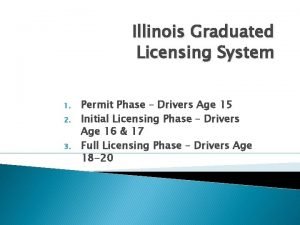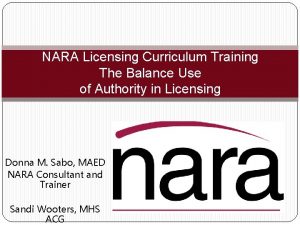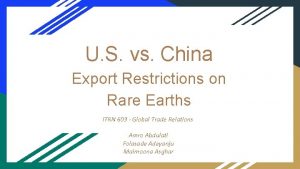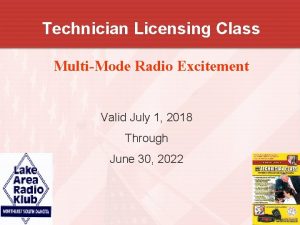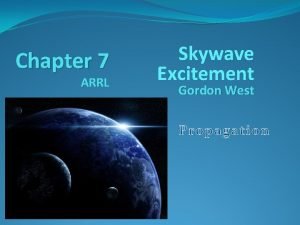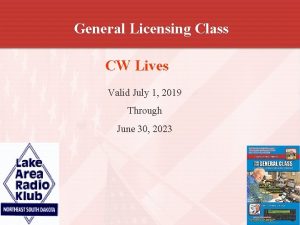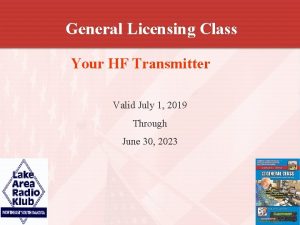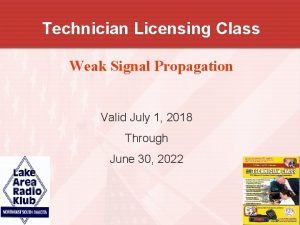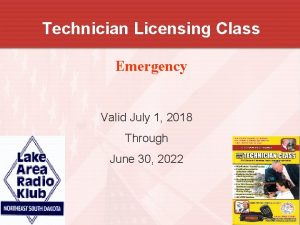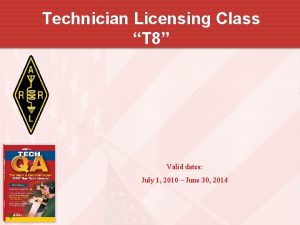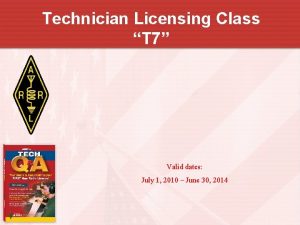General Licensing Class Skywave Excitement Valid July 1


































































- Slides: 66

General Licensing Class Skywave Excitement Valid July 1, 2019 Through June 30, 2023

Amateur Radio General Class Element 3 Course Presentation Ø ELEMENT 3 SUB-ELEMENTS (Groupings) Ø 1 - Your Passing CSCE Ø 2 - Your New General Bands Ø 3 - FCC Rules Ø 4 - Be a VE Ø 5 - Voice Operations Ø 6 - CW Lives Ø 7 - Digital Operating Ø 8 - In An Emergency Ø 9 - Skywave Excitement 2

Amateur Radio General Class Element 3 Course Presentation Ø ELEMENT 3 SUB-ELEMENTS (Groupings) Ø 10 - Your HF Transmitter Ø 11 - Your Receiver Ø 12 - Oscillators & Components Ø 13 - Electrical Principles Ø 14 - Circuits Ø 15 - Good Grounds Ø 16 - HF Antennas Ø 17 - Coax Cable Ø 18 - RF & Electrical Safety 3

Skywave Excitement Ø The F 2 region is mainly responsible for the longest distance radio wave propagation because it is the highest ionospheric region. (G 3 C 03)

Skywave Excitement Layers of the Atmosphere

Skywave Excitement Atmospheric Layers Terms we’ve heard before from space shuttle launches. Now apply them to Ham Radio Ionosphere 31 – 400 miles Stratosphere 6 – 31 miles Troposphere 0 – 6 miles

Skywave Excitement Regions in the Ionosphere During the day. . § The “D” Region is closest to Earth § The “D” Region absorbs MF/HF radio signals § The “F 2” Region is most responsible for long distance communication At night. . § The “D” & “E” Regions disappear § The “F 1” & “F 2” Regions combine into one with reduced ionization

Skywave Excitement Ø 2, 500 miles is the approximate maximum distance along the Earth's surface that is normally covered in one hop using the F 2 region. (G 3 B 09) Ø Where the Sun is overhead, ionospheric layers reach their maximum height. (G 3 C 02) The ionosphere is what makes long-distance radio communications possible on the shortwave bands. The ionosphere is made up of three layers of charged particles, labeled D, E, and F.

Skywave Excitement Ø The highest takeoff angle that will return a radio wave to the Earth under specific ionospheric conditions is called the critical angle. (G 3 C 04) One factor that affects how well the ionosphere will reflect a signal is the angle at which the signal impinges upon it. If the angle is too high, it will pass right through the ionosphere and not be reflected back to earth.

Skywave Excitement Ø MUF stand for the Maximum Usable Frequency for communications between two points. (G 3 B 08) Ø When they are sent into the ionosphere, radio waves with frequencies below the Maximum Usable Frequency (MUF) and above the Lowest Usable Frequency (LUF) are bent back to the Earth. (G 3 B 05) Ø A reliable way to determine if the Maximum Usable Frequency (MUF) is high enough to support skip propagation between your station and a distant location on frequencies between 14 and 30 MHz is to listen for signals from an international beacon. (G 3 B 04) There are websites that provide skywave DX conditions.

Skywave Excitement Ø When selecting a frequency for lowest attenuation when transmitting on HF, select a frequency just below the MUF. (G 3 B 03) Ø The following factors affect the Maximum Usable Frequency (MUF) (G 3 B 02) Ø Path distance and location Ø Time of day and season Ø Solar radiation and ionospheric disturbances All of these choices are correct. Ø 1, 200 miles is the approximate maximum distance along the Earth's surface that is normally covered in one hop using the E region. (G 3 B 10)

Skywave Excitement Ø Weak Signal Propagation Reporter WSPR is a digital mode using low-power beacons to assess HF propagation (G 8 C 02) Ø The D layer of the ionosphere is most absorbent of skip during daylight hours (G 3 C 11)

Skywave Excitement Ø The ionospheric layer closest to the surface of the Earth is the D layer. (G 3 C 01) Altitudes in Miles of Ionospheric Layers Day F Layer E Layer D Layer

Skywave Excitement Ø Long distance communication on the 40, 60, 80 and 160 meter bands is more difficult during the day because the D layer absorbs signals at these frequencies during daylight hours. (G 3 C 05) Ø During the summer lower HF frequencies suffer from higher noise or static. (G 2 D 11) Ø LUF stands for the Lowest Usable Frequency for communications between two points. (G 3 B 07) Ø When they are sent into the ionosphere, radio waves with frequencies below the Lowest Usable Frequency (LUF) are completely absorbed by the ionosphere. (G 3 B 06) Ø No HF radio frequency will support ordinary skywave communications over the path when the Lowest Usable Frequency (LUF) exceeds the Maximum Usable Frequency (MUF). (G 3 B 11)

Skywave Excitement Ø One interesting propagation phenomenon is scatter propagation. Scatter propagation allows a signal to be detected at a distance too far for ground wave propagation but too near for normal sky-wave propagation. (G 3 C 09) Scatter

Skywave Excitement Ø HF scatter signals in the skip zone are usually weak because only a small part of the signal energy is scattered into the skip zone. (G 3 C 08) Ø A characteristic of HF scatter signals is that they have a wavering sound. (G 3 C 06) Ø HF scatter signals often sound distorted because energy is scattered into the skip zone through several different radio wave paths. (G 3 C 07)

Skywave Excitement Ø An azimuthal projection map is a world map projection centered on a particular location it show true bearings and distance from a particular location. (G 2 D 04) Ø While signals most often take the shortest path from point to point, sometimes the best path for radio propagation is in the opposite direction, also called the “long path. ” A welldefined echo might be heard if a skywave signal arrives at your receiver by both short path and long path propagation. (G 3 B 01) Centered on Dallas, Texas

Skywave Excitement Ø Most communications take place on the “short path, ” that is the most direct path between two stations. At times, however, propagation may favor the long path. A directional antenna is pointed 180 degrees from its short-path heading when making a “long-path” contact with another station. (G 2 D 06)

Skywave Excitement Ø Higher sunspot numbers generally indicate a greater probability of good propagation at higher frequencies. (G 3 A 01) Ø The sunspot cycle is a long-term phenomenon. There are other phenomena that affect radio wave propagation in the short term. For example, the Sun’s rotation on its axis causes HF propagation conditions to vary periodically in a 28 -day cycle. (G 3 A 10) Solar flares and sunspots affect radiowave propagation

Skywave Excitement Ø 21 MHz and higher are the amateur radio HF frequencies that are least reliable for long distance communications during periods of low solar activity. (G 3 A 04) Ø The solar-flux index is a measure of solar radiation at 10. 7 cm. (G 3 A 05) 10. 7 cm wavelength = 2. 80 GHz

Skywave Excitement Ø There are two indices that give an indication of the stability of the Earth’s magnetic field. The K-index indicates the short term stability of the Earth’s magnetic field. (G 3 A 12) Ø The A-index indicates the long term stability of the Earth’s geomagnetic field. (G 3 A 13) K Index A Index HF Skip Conditions K 1 - K 4 A 0 - A 7 Bands are normal K 4 A 8 - A 15 Bands are unsettled K 4 A 16 - A 30 Bands are unpredictable K 5 A 30 - A 50 Lower bands are unstable K 6 A 50 - A 99 Few skywaves below 15 MHz K 7 - K 9 A 100 - A 400 Radio blackout is likely Go fishing or watch for an aurora.

Skywave Excitement Ø 8 minutes is approximately how long it takes for the increased ultraviolet and Xray radiation from solar flares to affect radio-wave propagation on the Earth. (G 3 A 03) Ø Geomagnetic activity, such as a geomagnetic storm, can also affect radio propagation. A geomagnetic storm is a temporary disturbance in the Earth's magnetosphere. (G 3 A 06)

Skywave Excitement Ø The effect a Sudden Ionospheric Disturbance has on the daytime ionospheric propagation of HF radio waves is that it disrupts signals on lower frequencies more than those on higher frequencies. (G 3 A 02) A Sudden Ionic Disturbance (SID) is a phenomenon that can have a drastic effect on propagation. During an SID, the sun emits a great deal of ultraviolet and X-ray radiation.

Skywave Excitement Ø One of the effects a geomagnetic storm can have on radio-wave propagation is degraded high-latitude HF propagation. (G 3 A 08) Ø A possible benefit to radio communications resulting from periods of high geomagnetic activity is that the aurora that can reflect VHF signals. (G 3 A 09) Geomagnetic disturbances caused by the Sun result in the Northern Lights.

Skywave Excitement Ø It takes 20 to 40 hours for charged particles from Coronal Mass Ejections (CME) to affect radio-wave propagation on the Earth. (G 3 A 11) A coronal mass ejection (CME) is a massive burst of solar wind and magnetic fields rising above the solar corona or being released into space. Coronal Mass Ejections take 20 – 40 hours to reach the earth where ultraviolet and X-Ray radiation from solar flares take 8 minutes.

Skywave Excitement Ø HF communications are disturbed by the charged particles that reach the Earth from solar coronal holes. (G 3 A 14) Ø At any point in the solar cycle, the 20 meter band usually supports worldwide propagation during daylight hours. (G 3 A 07) The antenna sends the signal at an angle of close to 90 degrees, and if conditions are right, the ionosphere reflects that signal back to the earth at a very short distance from the transmitting station.

Element 3 General Class Question Pool Skywave Excitement Valid July 1, 2019 Through June 30, 2023

G 3 C 03 Why is the F 2 region mainly responsible for the longest distance radio wave propagation? A. Because it is the densest ionospheric layer B. Because it does not absorb radio waves as much as other ionospheric regions C. Because it is the highest ionospheric region D. All of these choices are correct

G 3 B 09 What is the approximate maximum distance along the Earth's surface that is normally covered in one hop using the F 2 region? A. 180 miles B. 1, 200 miles C. 2, 500 miles D. 12, 000 miles

G 3 C 02 Where on the Earth do ionospheric layers reach their maximum height? A. Where the Sun is overhead. B. Where the Sun is on the opposite side of the Earth. C. Where the Sun is rising. D. Where the Sun has just set.

G 3 C 04 What does the term “critical angle” mean as used in radio wave propagation? A. The long path azimuth of a distant station B. The short path azimuth of a distant station C. The lowest takeoff angle that will return a radio wave to the Earth under specific ionospheric conditions D. The highest takeoff angle that will return a radio wave to the Earth under specific ionospheric conditions

G 3 B 08 What does MUF stand for? A. The Minimum Usable Frequency for communications between two points B. The Maximum Usable Frequency for communications between two points C. The Minimum Usable Frequency during a 24 hour period D. The Maximum Usable Frequency during a 24 hour period

G 3 B 07 What does LUF stand for? A. The Lowest Usable Frequency for communications between two points B. The Longest Universal Function for communications between two points C. The Lowest Usable Frequency during a 24 hour period D. The Longest Universal Function during a 24 hour period

G 3 B 06 What usually happens to radio waves with frequencies below the Lowest Usable Frequency (LUF)? A. They are bent back to the Earth B. They pass through the ionosphere C. They are completely absorbed by the ionosphere D. They are bent and trapped in the ionosphere to circle the Earth

G 3 B 11 What happens to HF propagation when the Lowest Usable Frequency (LUF) exceeds the Maximum Usable Frequency (MUF)? A. No HF radio frequency will support communications over the path. B. HF communications over the path are enhanced. C. Double hop propagation along the path is more common D. Propagation over the path on all HF frequencies is enhanced

G 3 B 05 What usually happens to radio waves with frequencies below the MUF and above the LUF when they are sent the ionosphere? A. They are bent back to the Earth B. They pass through the ionosphere C. They are amplified by interaction with the ionosphere D. They are bent and trapped in the ionosphere to circle the Earth into

G 3 B 04 What is a reliable way to determine if the Maximum Usable Frequency (MUF) is high enough to support skip propagation between your station and a distant location on frequencies between 14 and 30 MHz? A. Listen for signals from an international beacon in the frequency range you plan to use B. Send a series of dots on the band listen for echoes from your signal C. Check the strength of TV signals from Western Europe D. Check the strength of signals in the MF AM broadcast band

G 8 C 02 Which digital mode is used as a low-power beacon for assessing HF propagation? A. WSPR B. Olivia C. PSK 31 D. SSB-SC

G 3 B 03 Which of the following applies when selecting a frequency for lowest attenuation when transmitting on HF? A. Select a frequency just below the MUF B. Select a frequency just above the LUF C. Select a frequency just below the critical frequency D. Select a frequency just above the critical frequency

G 3 B 02 What factors affect the MUF? A. Path distance and location B. Time of day and season C. Solar radiation and ionospheric disturbances D. All of these choices are correct 40

G 3 B 10 What is the approximate maximum distance along the Earth's surface that is normally covered in one hop using the E region? A. 180 miles B. 1, 200 miles C. 2, 500 miles D. 12, 000 miles

G 3 C 01 Which of the following ionospheric layers is closest to the surface of the Earth? A. The D layer B. The E layer C. The F 1 layer D. The F 2 layer

G 3 C 11 Which ionospheric layer is the most absorbent of long skip signals during daylight hours on frequencies below 10 MHz? A. The F 2 layer B. The F 1 layer C. The E layer D. The D layer

G 3 C 05 Why is long distance communication on the 40, 60, 80 and 160 meter bands more difficult during the day? A. The F layer absorbs these frequencies during daylight hours B. The F layer is unstable during daylight hours C. The D layer absorbs these frequencies during daylight hours D. The E layer is unstable during daylight hours

G 2 D 11 Which of the following is typical of the lower HF frequencies during the summer? A. Poor propagation at any time of day B. World-wide propagation during the daylight hours C. Heavy distortion on signals due to photon absorption D. High levels of atmospheric noise or “static” 45

G 3 C 09 What type of propagation allows signals to be heard in the transmitting station’s skip zone? A. Faraday rotation. B. Scatter C. Sporadic-E skip D. Short-path skip

G 3 C 08 Why are HF scatter signals in the skip zone usually weak? A. Only a small part of the signal energy is scattered into the skip zone. B. Signals are scattered from the magnetosphere which is not a good reflector. C. Propagation is through ground waves which absorb most of the signal energy. D. Propagations is through ducts in F region which absorb most of the energy.

G 3 C 07 What makes HF scatter signals often sound distorted? A. The ionospheric layer involved is unstable B. Ground waves are absorbing much of the signal C. The E-region is not present D. Energy is scattered into the skip zone through several radio wave paths

G 3 C 06 What is a characteristic of HF scatter? A. Phone signals have high intelligibility B. Signals have a fluttering sound C. There are very large, sudden swings in signal strength D. Scatter propagation occurs only at night

G 2 D 04 Which of the following describes an azimuthal projection map? A. A map that shows accurate land masses. B. A map that shows true bearings and distances from a particular location C. A map that shows the angle at which an amateur satellite crosses the equator D. A map that shows the number of degrees longitude that an amateur satellite appears to move westward at the equator with each orbit

G 3 B 01 What is a characteristic of skywave signals arriving at your location by both short-path and long-path propagation? A. Periodic fading approximately every 10 seconds B. Signal strength increased by 3 d. B C. The signal will be cancelled causing severe attenuation D. A slightly delayed echo might be heard

G 2 D 06 How is a directional antenna pointed when making a “long-path” contact with another station? A. Toward the rising sun B. Along the Gray Line C. 180 degrees from its short-path heading D. Toward the North

G 3 A 01 What is the significance of the sunspot number with regard to HF propagation? A. Higher sunspot numbers generally indicate a greater probability of good propagation at higher frequencies B. Lower sunspot numbers generally indicate greater probability of sporadic E propagation C. A zero sunspot number indicate radio propagation is not possible on any band D. All of these choices are correct

G 3 A 10 What causes HF propagation conditions to vary periodically in a 28 -day cycle? A. Long term oscillations in the upper atmosphere. B. Cyclic variation in the Earth’s radiation belts. C. The Sun’s rotation on its axis. D. The position of the Moon in its orbit.

G 3 A 09 What benefit can high geomagnetic activity have on radio communications? A. Auroras that can reflect VHF signals B. Higher signal strength for HF signals passing through the polar regions C. Improved HF long path propagation D. Reduced long delayed echoes

G 3 A 04 Which of the following amateur radio HF frequencies are least reliable for long distance communications during periods of low solar activity? A. 80 meters and 160 meters B. 60 meters and 40 meters C. 30 meters and 20 meters D. 15 meters, 12 meters, and 10 meters

G 3 A 05 What is the solar-flux index? A. A measure of the highest frequency that is useful for ionospheric propagation between two points on the Earth. B. A count of sunspots which is adjusted for solar emissions. C. Another name for the American sunspot number. D. A measure of solar radiation at 10. 7 cm.

G 3 A 12 What does the K-index indicate? A. The relative position of sunspots on the surface of the sun. B. The short term stability of the Earth’s magnetic field. C. The stability of the Sun's magnetic field. D. The solar radio flux at Boulder, Colorado.

G 3 A 13 What does the A-index indicate? A. The relative position of sunspots on the surface of the sun. B. The amount of polarization of the Sun's electric field. C. The long term stability of the Earth’s geomagnetic field. D. The solar radio flux at Boulder, Colorado.

G 3 A 03 Approximately how long does it take the increased ultraviolet and X-ray radiation from solar flares to affect radio propagation on the Earth? A. 28 days. B. 1 to 2 hours. C. 8 minutes D. 20 to 40 hours.

G 3 A 06 What is a geomagnetic storm? A. A sudden drop in the solar-flux index. B. A thunderstorm which affects radio propagation. C. Ripples in the ionosphere D. A temporary disturbance in the Earth's magnetosphere.

G 3 A 02 What effect does a Sudden Ionospheric Disturbance have on the daytime ionospheric propagation of HF radio waves? A. It enhances propagation on all HF frequencies. B. It disrupts signals on lower frequencies more than those on higher frequencies. C. It disrupts communications via satellite more than direct communications. D. None, because only areas on the night side of the Earth are affected.

G 3 A 08 Which of the following effects can a geomagnetic storm have on radio-wave propagation? A. Improved high-latitude HF propagation B. Degraded high-latitude HF propagation C. Improved ground-wave propagation D. Improved chances of UHF ducting

G 3 A 11 How long does it take charged particles from coronal mass ejections to affect radio propagation on Earth? A. 28 days B. 14 days C. 4 to 8 minutes D. 20 to 40 hours

G 3 A 14 How are radio communications usually affected by the charged particles that reach the Earth from solar coronal holes? A. HF communications are improved B. HF communications are disturbed C. VHF/UHF ducting is improved D. VHF/UHF ducting is disturbed

G 3 A 07 At what point in the solar cycle does the 20 meter band usually support worldwide propagation during daylight hours? A. At the summer solstice B. Only at the maximum point of the solar cycle C. Only at the minimum point of the solar cycle D. At any point in the solar cycle
 Skywave zenith
Skywave zenith Show don't tell excitement
Show don't tell excitement Excite prefix and suffix
Excite prefix and suffix A feeling of growing tension and excitement
A feeling of growing tension and excitement Excited show not tell
Excited show not tell Excitement interjections
Excitement interjections Excited as a simile
Excited as a simile Ironic essay examples
Ironic essay examples Eosc 110 pre class quiz
Eosc 110 pre class quiz Although frieda is typically very reserved as
Although frieda is typically very reserved as A strange day in july picture
A strange day in july picture Harris burdick uninvited guest
Harris burdick uninvited guest July 1-4 1863
July 1-4 1863 Gcc july 2020
Gcc july 2020 Astronomy picture of the day 11 july 2001
Astronomy picture of the day 11 july 2001 2001 july 15
2001 july 15 2003 july 17
2003 july 17 July 30 2009 nasa
July 30 2009 nasa Sources nso frenchhowell neill mit technology...
Sources nso frenchhowell neill mit technology... What is the significance of july 4 1776 brainpop
What is the significance of july 4 1776 brainpop I am silver and exact i have no preconceptions
I am silver and exact i have no preconceptions Miss cuba receives an invitation
Miss cuba receives an invitation Poppies in july imagery
Poppies in july imagery July 10 1856
July 10 1856 Ctdssmap payment schedule july 2021
Ctdssmap payment schedule july 2021 July 1969
July 1969 6th july 1988
6th july 1988 Monday 13th july
Monday 13th july On july 18 2001 a train carrying hazardous chemicals
On july 18 2001 a train carrying hazardous chemicals July 4 sermon
July 4 sermon June too soon july stand by
June too soon july stand by July 2 1937 amelia earhart
July 2 1937 amelia earhart June 22 to july 22
June 22 to july 22 July 12 1776
July 12 1776 Sensory language definition
Sensory language definition Super saturday tribal bingo july 4
Super saturday tribal bingo july 4 April may june july august
April may june july august July 14 1789
July 14 1789 Malaga in july
Malaga in july Leaf yeast
Leaf yeast July 26 1953
July 26 1953 July 16 1776
July 16 1776 Wi ems wards
Wi ems wards Veritas vems
Veritas vems Virginia dbhds human rights regulations
Virginia dbhds human rights regulations Fais penn state
Fais penn state Smeal qualtrics
Smeal qualtrics Qlikview licensing
Qlikview licensing Module 4 - open source software and licensing
Module 4 - open source software and licensing Microsoft education licensing
Microsoft education licensing Mcoles shooting qualification
Mcoles shooting qualification Louisiana department of health and hospitals
Louisiana department of health and hospitals Licensing in sports
Licensing in sports Railway board letter on land management
Railway board letter on land management Industries requiring compulsory licensing *
Industries requiring compulsory licensing * Graduated license illinois
Graduated license illinois Utah child care licensing
Utah child care licensing Licensing franchising and other contractual strategies
Licensing franchising and other contractual strategies Umw post office
Umw post office Oregon health licensing agency
Oregon health licensing agency Mvls licensing
Mvls licensing Microsoft spla reporting software
Microsoft spla reporting software Nara licensing
Nara licensing School business administrator licensing
School business administrator licensing Natural health products regulations ontario
Natural health products regulations ontario Microsoft action pack lizenzen übersicht
Microsoft action pack lizenzen übersicht Export licensing requirements
Export licensing requirements
